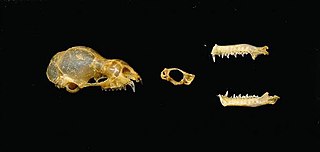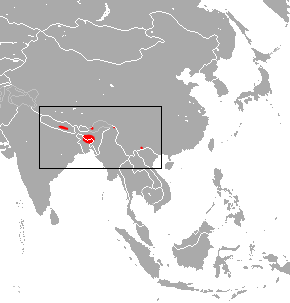
The genus Plecotus consists of the long-eared bats. Many species in the genus have only been described and recognized in recent years.
The Java pipistrelle is a species of pipistrelle bat found in South and Southeast Asia, including Afghanistan; Bangladesh; Brunei; Cambodia; China; India; Indonesia; Laos; Malaysia; Myanmar; Nepal; Pakistan; Philippines; Singapore; Thailand and Vietnam. It favors human habitations. A 2010 research paper from the Philippines regarding the prevalence of coronavirus in bats tested several Java pipistrelle bats.
The mountain noctule is a species of bat found in Afghanistan, India, Pakistan, and Nepal.

The least pipistrelle is a species of vesper bat.
The Gobi big brown bat is a species of vesper bat. It is found in Afghanistan, China, India, Mongolia, Pakistan, and Russia. Russian zoologist Professor Count Nikolay Alekseyevich Bobrinski first described it in 1926, the type specimen coming from the Altai Mountains in the Gobi Desert.
The thick-eared bat is a species of vesper bat native to China, India, Myanmar, Bangladesh and Thailand. Very little is known about the status and ecology of this bat, except that it may prefer to inhabit tropical moist deciduous forests.

The greater Asiatic yellow bat is a species of vesper bat.

The Canary big-eared bat, also known as the Tenerife long-eared bat is a species of vesper bat endemic to the Canary Islands. According to the IUCN, it is vulnerable to the risk of extinction. The species is primarily found in woodland habitat at elevations between 100 and 2300 m. It feeds mainly on moths. Roosting sites include caves, lava tubes and abandoned buildings.
Hutton's tube-nosed bat is a species of vesper bat in the family Vespertilionidae. It can be found in the following countries: China, India, Laos, Malaysia, Myanmar, Nepal, Pakistan, Thailand, and Viet Nam. It lives within an elevation of 1450 m to 2500 m. In Southeast Asia, the bat is considered to be uncommon. The bat is known to live in forests, roosting among the leaves of banana trees. Its habitat is threatened by deforestation for firewood and timber, as well as conversion to agricultural land.

The black-gilded pipistrelle, also known as the bronze sprite, is a species of vesper bat found in China, India, Myanmar, and Nepal.
Mandelli's mouse-eared bat is a species of vesper bat. It can be found in India and Nepal. It is found in subtropical or tropical moist montane forests. It is threatened by habitat loss. The name honours the ornithologist Louis Mandelli.

The ashy roundleaf bat is a species of bat in the family Hipposideridae found in India, Indonesia, Laos, Malaysia, Myanmar, Pakistan, Thailand, and Vietnam.

The fulvus roundleaf bat or fulvus leaf-nosed bat is a species of bat in the family Hipposideridae. It is found in Afghanistan, Bangladesh, Cambodia, China, India, Laos, Myanmar, Pakistan, Sri Lanka and Thailand and possibly in Vietnam.

The Indian pipistrelle is a species of bat in the family Vespertilionidae found in Afghanistan, Bangladesh, Bhutan, Cambodia, India, Myanmar, Nepal, Pakistan, Sri Lanka, Thailand, and Vietnam.

Blyth's horseshoe bat is a species of bat in the family Rhinolophidae. It is found across southern Asia from Afghanistan to Vietnam. The species can be identified from its pointed, bifid sella.

The big-eared horseshoe bat is a bat species within the Rhinolophidae native to China, India, Indonesia, Laos, Malaysia, Nepal, Pakistan, the Philippines, Thailand, and Vietnam.

The rufous horseshoe bat is a species of bat in the family Rhinolophidae. It is found in China, India, Myanmar, Nepal, Sri Lanka, and Vietnam.

The little Nepalese horseshoe bat is a species of bat in the family Rhinolophidae. It is found in Bangladesh, China, India, Myanmar and Nepal, possibly in Bhutan.
Plecotus turkmenicus is a species of bat in the family Vespertilionidae. It is found in Kazakhstan and Turkmenistan.
Eptesicus pachyomus is a species of bat in the family Vespertilionidae. It is widespread and found throughout Asia.












